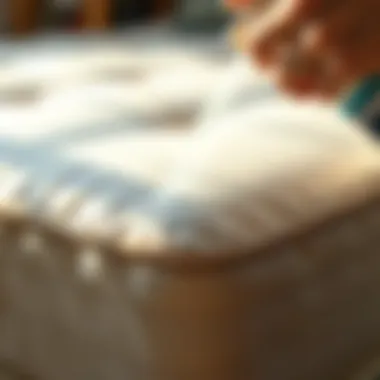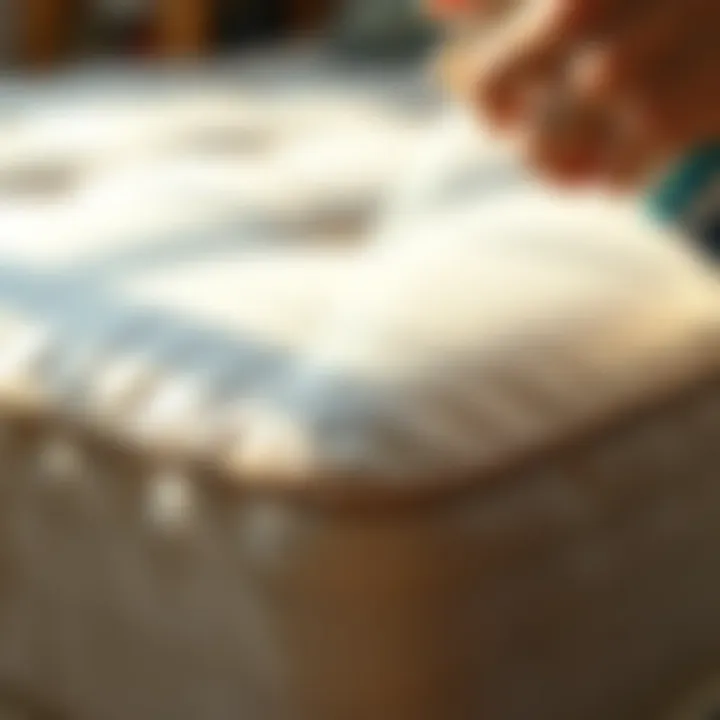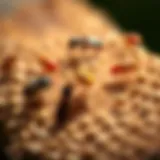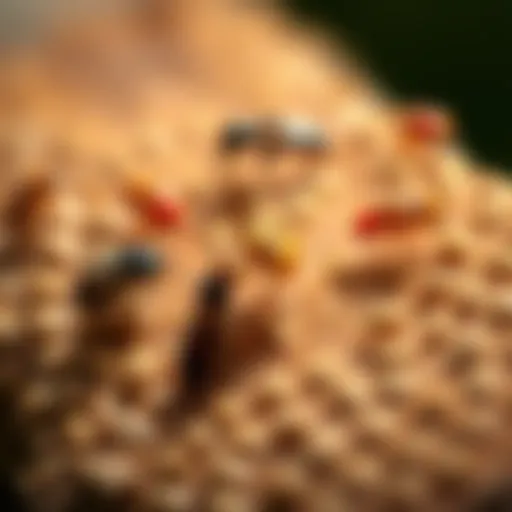Applying Bed Bug Spray on Mattresses: A Complete Guide


Intro
Welcome to a thorough exploration of bed bug spray application on mattresses. If you’ve found yourself itching at night or waking with unexplained bites, you might be dealing with a burgeoning bed bug problem. Understanding how to effectively use bed bug spray can make the difference between a long, sleepless night and swiftly taking control of your living space. In this guide, we’ll walk through the crucial steps of identifying these pests, how to prepare your environment, and the comprehension of practical application techniques.
Keeping your home bug-free is no small feat, especially when it comes to these tenacious creatures. But fear not; armed with the right knowledge, you can tackle bed bug infestations confidently. Let’s jump right into pest identification, a vital first step toward treatment.
Pest Identification
Before diving into the remedy, you must first know what you are up against. Bed bugs are notorious for their resilience and can wreak havoc if left unchecked.
Common Household Pests
While there are various pests that can invade your home, bed bugs deserve a special mention due to their specific habits and habitats. These tiny critters are typically nocturnal and feed on human blood. They hide in cracks and crevices, often going unnoticed until the situation becomes dire. Some other common household pests to be aware of include:
- Cockroaches
- Ants
- Termites
- Rodents
While each pest has its own unique characteristics, the telltale signs of bed bugs set them apart.
Signs of Infestation
Recognizing the signs of a bed bug infestation can help you act before it escalates. Look out for the following indicators:
- Bites: Small, red welts on the skin often in a line or clustered.
- Stains on Bedding: Dark spots or rust stains on your sheets or mattress.
- Eggs and Shells: Tiny, yellowish eggs (about the size of a pinhead) and shed skins.
- Odor: A musty or sweet smell, if the infestation is severe enough.
"The only way to really ensure you’re rid of bed bugs is by being proactive and persistent in your approach."
Understanding these signs not only helps in identifying the problem but also aids in determining the best course of action.
Prevention Methods
Once pests have been identified, preventing further infestations becomes the next logical step. Knowledge is key in outsmarting these unwelcome guests.
Environmental Modifications
Making changes to your environment can significantly reduce the likelihood of infestation. Consider these strategies:
- Reduce Clutter: Keeping your space tidy minimizes hiding spots for bed bugs.
- Seal Cracks: Inspect and caulk any gaps in your home’s walls, floors, and furniture.
- Use Mattress Covers: Encase your mattresses and box springs with protective covers.
Home Maintenance Tips
Regular maintenance can keep your home more resilient against pests:
- Routine Vacuuming: Regularly vacuum all nooks of your home, focusing on areas where bed bugs might hide.
- Washing Bedding: Frequently wash and dry bedding on high heat to eliminate eggs and bugs.
- Inspect Used Furniture: Be cautious with secondhand items, always inspecting for signs of bed bugs before bringing them inside.
Implementing these measures can fortify your home against future infractions and create a less inviting environment for bed bugs.
DIY Pest Control Solutions
As the adage goes, "neither here nor there!"; sometimes being proactive with your pest control can save you headaches down the line. Let’s explore some effective DIY solutions.
Natural Remedies
Some households prefer to avoid chemical solutions. Here are a few natural alternatives:
- Diatomaceous Earth: This fine powder can dehydrate and kill bed bugs upon contact.
- Essential Oils: Oils like tea tree and lavender may repel bed bugs, though they may not eradicate them entirely.
- Steam Cleaning: High heat from steam can kill bugs and their eggs on contact.
DIY Traps and Barriers
Creating simple barriers or traps can also aid in battling these pests. Consider using:
- Sticky Tape: Place tape around bed legs to trap bed bugs attempting to crawl up.
- Alcohol Sprays: A solution of isopropyl alcohol can kill bugs on contact. However, be careful as this is flammable.
By deploying these ingenious techniques, you can fortify your defense against bed bugs while saving yourself some money.
Understanding Bed Bugs
Understanding bed bugs is the cornerstone of effectively managing an infestation and applying bed bug spray to mattresses. These pests are more than just a nuisance; they are adept at hiding and can rapidly reproduce. Knowing the ins and outs of these little critters will go a long way in addressing an infestation.


Biology of Bed Bugs
Bed bugs, scientifically known as Cimex lectularius, are small, wingless insects that thrive on human blood. Adult bed bugs measure approximately 4 to 5 mm in length, roughly the size of an apple seed. Their bodies are flat and oval-shaped, which allows them to nestle into tiny crevices with ease. They exhibit a semi-translucent brownish hue that can become darker after feeding, making it essential to check for both live bugs and shed skins in your mattress seams.
Their reproductive habits are noteworthy; a single female can lay 200 to 500 eggs throughout her life, often in clusters. In optimal conditions, these eggs hatch in about six to ten days, leading to rapid population growth if not promptly addressed. One of the crucial aspects to consider is their hunger for blood, typically feeding every five to ten days but can survive for months without a meal if necessary. This makes understanding their life cycle essential for effective treatment.
Common Signs of Infestation
Identifying a bed bug infestation can sometimes be tricky. Here are some common signs to look for:
- Blood Stains: Tiny rust-colored stains on your sheets or mattress can indicate crushed bed bugs or blood spots from feeding.
- Fecal Spots: Dark, speck-like droppings can be found along seams or edges.
- Bed Bug Molts: Shells that look like little brown casings can signal that bed bugs are present and growing.
- Bites: Unexplained bites on your skin, often in clusters or a line, are a red flag.
Awareness of these signs is your first line of defense, as early detection can significantly ease control efforts.
Health Impacts of Bed Bug Bites
While bed bugs are not known to transmit diseases like some other pests, their bites can still have health ramifications. Bite symptoms vary among individuals, but generally include:
- - Red, itchy welts: Ranging from small bumps to larger swollen areas.
- - Allergic reactions: Some people may experience severe reactions, which could necessitate medical attention.
- - Secondary infections: Scratching bites can lead to skin infections or other complications if not managed properly.
These health impacts are sometimes underestimated but can lead to significant discomfort, which is why a proactive approach is essential.
"Ignoring the signs of bed bugs is like turning a blind eye to a thief in the night. Recognizing and addressing them quickly can save you a world of trouble."
By grasping the basics of bed bug biology, recognizing signs of infestations, and understanding potential health impacts, you set the stage for effective bed bug management. The following sections will delve into selection, application techniques, and the pitfalls to avoid in this ongoing battle against these unwelcome guests.
Types of Bed Bug Sprays
Understanding the different types of bed bug sprays available on the market is crucial for effectively tackling infestations. Each type of spray comes with its own advantages and limitations, which can impact the success rates of pest control efforts. Decision-making can get tough with options like chemical-based products or natural alternatives, but knowing the distinctions is vital for homeowners striving to clear out their space. Choosing the wrong type of spray could save you some bucks initially, but it might lead to greater expenses down the line.
Chemical-Based Sprays
Chemical-based bed bug sprays often top the list for many facing pest problems. These products harness synthetic insecticides to eliminate bed bugs quickly. Common active ingredients include pyrethroids and neonicotinoids, both designed to attack the nervous system of pests, leading to their demise.
While these sprays show effective outcomes in the short term, it’s important to note a few considerations:
- Fast-acting: They often provide quick relief, killing bugs on contact.
- Broad Spectrum: They can also target other pests like roaches and ants.
- Resistance Issues: Over time, bed bugs may build resistance to specific chemicals, rendering them less effective. This can lead to a cycle of application that simply doesn’t work anymore.
Be aware that some of these sprays might carry strong odors and chemicals that can be harmful if inhaled or ingested, making proper safety measures essential.
Natural Alternatives
On the flip side, natural alternatives to chemical sprays are gaining traction among those looking to minimize chemical exposure. Solutions often include plant-based ingredients or essential oils that are somewhat effective against bed bugs. Common examples are tea tree oil, lavender oil, and diatomaceous earth.
Why might someone choose these options? Here are a few benefits:
- Eco-Friendly: These sprays contribute less to indoor air pollution and are safer for children and pets.
- Less Toxicity: Many people prefer the peace of mind that comes with using non-harmful alternatives.
- Repellent Properties: Some natural ingredients can deter future infestations while also targeting residing pests.
However, keep in mind that natural doesn’t always mean effective. Results can be hit or miss, varying based on the concentration of the active ingredients and specific infestation levels. Sometimes, patience becomes a significant factor here as these alternatives take longer to show their effects.
Comparative Efficacy
When considering the comparative efficacy of chemical vs. natural options, it’s evident that both types of sprays have their respective strengths and weaknesses.
- Speed: Chemical sprays deliver fast results, while natural alternatives might work more slowly.
- Safety: Natural sprays score higher in terms of everyday safety for human and pet exposure.
- Resistance: The likelihood of chemical resistance becomes an essential factor with ongoing applications of synthetic sprays, while natural products typically don’t lead to this concern.
In summary, selecting the right spray boils down to your specific needs, the severity of the infestation, and your comfort level with chemicals in your home environment. Each method demands a careful consideration of trade-offs and effectiveness in the face of trying to reclaim a bed bug-free living space.
"The right choice between chemical and natural sprays could be the crunch time for handling pest infestations efficiently."
By understanding these differences, homeowners can make informed decisions, ensuring they approach bed bug eradication with a strategy tailored to their unique situation.
Preparing for Application
Before diving into the nitty-gritty of applying bed bug spray on your mattress, it's vital to prepare the ground—not just figuratively, but literally. Think of this stage as setting the stage for a performance; you wouldn’t waltz onto a cluttered set. Getting ready helps ensure that your pest control efforts will bear fruit and keeps you and your family safe.
Gathering Necessary Supplies


The first order of business is gathering the right supplies. You wouldn’t cook a gourmet meal without the necessary ingredients, so why tackle a bed bug problem without essential tools?
- Bed bug spray – Pick one that suits your needs, be it a chemical-based solution like Hot Shot Bed Bug Killer or a natural one such as EcoSMART Organic Bed Bug Killer.
- Protective gear – Gloves and a mask are necessary to keep yourself protected from potentially harmful fumes.
- Spray bottle – If your chosen product doesn’t come in a convenient spray bottle, it might be worth investing in one; it gives you more control.
- Flashlight – You will want to inspect dark nooks and crannies. A bright light can help you spot what you need to treat.
- Cleaning supplies – Have a vacuum, broom, and detergent ready for a thorough cleaning post-application.
Remember, it’s better to have everything at your fingertips than to run back and forth like a headless chicken.
Clearing the Area
Next comes clearing the area. This part isn’t just a matter of tidying up. It effectively sets the tone for successful application. Go around your mattress and remove any items that could block your efforts or act as a hiding spot for bed bugs. Prioritize the following:
- Remove bedding – Take off all sheets, pillows, and mattress covers. Wash them in hot water if possible.
- Dismantle nearby clutter – Move any nightstands, clothes, or piles of laundry away from the bed so you can have a clear line of attack.
- Vacuum – Quickly vacuum the mattress, the bed frame, and the floor around it; this can significantly reduce the number of bugs in the vicinity.
A clean and clear area means a focused effort, so don’t overlook this crucial step.
Safety Precautions
Now, let's talk about safety precautions. Spraying a chemical or natural pesticide can carry risks, and being safe is key. Think of your home as a fortress; you want to ensure it’s secure against unwanted invaders without putting your family at risk.
- Ensure ventilation – Open windows and doors to allow fresh air to circulate. It reduces fume concentration—like airing out stale bread.
- Keep children and pets away – During application and until the spray dries, keep everything at a safe distance. It’s safer for everyone involved.
- Read product labels – Each treatment varies, and knowing the ins and outs of what you’re using is crucial. You wouldn’t hop onto a rollercoaster without checking the safety requirements first.
- Store products safely – After your battle, make sure to store sprays where kids can’t reach them, preferably locked away.
"Preparation is the key to success."
You’re setting up for an effective treatment; every precaution you take now can lead to a successful outcome in getting rid of those pesky bed bugs. By keeping these aspects in mind, you not only ensure a more effective treatment but also a safer environment for your loved ones.
Application Techniques
The Application Techniques section is fundamental to understanding how to effectively combat bed bug infestations. Applying bed bug spray properly can make a world of difference in the outcome of your pest control efforts. Understanding techniques not only enhances the effectiveness of the treatment but also ensures safety for both the individual applying it and the environment. In many cases, incorrect application can lead to reduced effectiveness or even exacerbate the infestation, making this section paramount in any guide on the subject.
Identifying Treatment Areas
Before you even think about spraying, you must pinpoint where to aim that canister. It’s not just about a general spraying spree; you need to know where these pesky critters like to hide. Bed bugs tend to inhabit specific areas, making targeted treatment essential. Key spots to focus on include:
- Seams and folds of the mattress: This is often where bed bugs take the best naps, tucked away safely.
- Bed frames and headboards: These are prime locations, as bed bugs love to stay close to their food source—us.
- Nearby furniture: Check any side tables or chairs next to the bed, as they can be potential hiding spots.
- Cracks and crevices: Bed bugs are known for their ability to squeeze into tight spaces. Ensuring these areas are treated can make your efforts more fruitful.
Being thorough in identifying these areas can save you time and provide a more comprehensive solution. Skipping a nook can turn into a headache when the bugs make a comeback.
Correct Spray Techniques
Now that you've found the treatment areas, let’s talk techniques. Applying the spray shouldn’t be done like tossing confetti at a party. Instead, employ precision and care. Here are some techniques to ensure you're on the right track:
- Distance is crucial: Hold the spray can about 8-10 inches from the surface. This distance allows for better coverage and minimizes the chances of oversaturation.
- Even strokes: Apply the spray in steady, even strokes rather than heavy bursts. This approach helps to coat the area without creating pools, which can be wasteful and less effective.
- Longer application time: If your canister allows, spray a bit longer on heavily infested areas to ensure the product penetrates effectively.
Using the right spray techniques means you can maximize the spray's efficacy while also minimizing the risks associated with improper application.
Timing and Coverage
Timing matters as much as technique. Understanding the right moments to spray, as well as ensuring adequate coverage, can significantly impact the success of your treatment. Here are some key aspects to consider:
- Daytime vs. Nighttime: Bed bugs are nocturnal. Spraying in the early morning or at night may allow the spray to work more effectively since bugs will be more active during these times.
- Coverage assurance: After spraying, ensure you’ve covered all identified hotspots adequately. This might include going back to areas where you’ve already sprayed to double-check that you've not overlooked any nooks.
- Duration of effectiveness: After applying, it's crucial to wait for the suggested drying time. Manufacturers usually specify this, so it’s worth looking on the canister to ensure you're allowing the product enough time to work.
Proper timing and coverage will compound the spraying’s power, meaning you’re not just throwing resources at a problem, but rather applying strategy against it.
"The right technique and timing can transform a battle against bed bugs into a winning strategy rather than one filled with setbacks."
By mastering identifying treatment areas, employing correct spray techniques, and understanding timing and coverage, you’re significantly increasing your chances of batteling a bed bug infestation effectively. Keep these principles in mind as you work through your pest control strategy.
Post-Application Care
After you’ve gone through the time-consuming process of applying bed bug spray, you’ve got to keep your eyes on the ball with post-application care. This phase isn’t just an afterthought, but rather a critical aspect of ensuring that the treatment you’ve conducted achieves its intended success. Proper care post-application can make all the difference in the ongoing battle against these tenacious pests. The importance lies in the fact that bed bugs can re-appear if not adequately monitored and treated.
Allowing Proper Drying Time
Ensure that you allow the sprayed areas sufficient time to dry thoroughly. This is not simply for cosmetic purposes; it’s crucial for the effectiveness of the spray itself. Some sprays need time to settle into surfaces, ensuring it adheres properly to any existing bugs or eggs hiding in the fabric of your mattress.
Generally, it’s wise to wait at least two to four hours before using the mattress again. During this time, avoid putting sheets back on, as the direct exposure to moisture can wash away the active ingredients in the spray. While waiting, it may be helpful to keep the room ventilated—this aids in drying as well as dispersing any lingering chemical smell.
Monitoring for Bed Bugs


Once your mattress is dry and ready for use, the next step involves vigilant monitoring. Don’t think for a second that your work is done—bed bugs are crafty and might manage to stick around despite your best efforts. Keeping an eye out for signs of their return is essential. Common indicators include itchy, red bites on your skin, or you may spot the small brownish stains on your sheets and mattress.
You might want to conduct regular checks by inspecting the seams of your mattress and bed frame. This could be once a week for a month or so. Pay special attention to the areas near the seams, tags, and any folds in the fabric, as bed bugs tend to take refuge in these tight spots. If you notice anything suspicious, don’t hesitate to take action. Catching an infestation early can save you a lot of hassle later.
When to Repeat Treatments
Determining when to retreat is a bit of an art. Many experts suggest following up with another treatment about two weeks after your initial application. This is particularly important as egg hatchings can occur during this window. If you performed proper monitoring but still see signs of bed bugs, don’t delay in applying another round of treatment.
Furthermore, if multiple people in your household are getting bites or seeing bed bug activity, it might be time for more aggressive tactics. Make it a habit to consult product instructions regarding application frequency and safety guidelines—each product can have different recommendations.
Remember: Consistency in follow-ups can significantly affect the eradication of bed bugs. Treating without follow-up can lead to frustration and prolonged infestations.
In summary, the post-application phase holds substantial significance in your fight against bed bugs. By ensuring proper drying, maintaining vigilant monitoring, and being judicious about repeat treatments, you can lay the groundwork for a bed bug-free home. Keep in mind that patience and diligence are your allies in this battle.
Common Mistakes to Avoid
When applying bed bug spray on mattresses, understanding the common missteps can greatly affect the outcome of your pest control efforts. Mistakes can lead to ineffective treatments, prolonging the infestation, and even risking your health. Avoiding pitfalls not only ensures a cleaner living space but also prolongs the life of your mattress. Let’s dive into some of the most frequent errors that homeowners might encounter.
Over-Saturation of Spray
One prevalent mistake many individuals make is over-saturating the mattress with spray.
Why is this a problem? An excessive amount of spray doesn’t just waste the product; it can lead to chemical buildup, risking damage to your mattress itself. Over-saturation may also create an unhealthy environment due to mold growth, especially in a damp setting. Moreover, too much spray can repel bed bugs rather than eliminate them, causing them to scatter into other areas of your home.
Instead of dousing the mattress, it is essential to adhere to the manufacturer’s instructions.
- Tip: Aim for a light mist rather than a soaking layer.
- Application Technique: Hold the spray nozzle about 12 to 15 inches away from the surface to ensure even distribution without excess.
Remember, less can indeed be more when it comes to applying bed bug sprays effectively.
Neglecting Follow-Up Inspections
After applying bed bug spray, many homeowners make the mistake of neglecting follow-up inspections. Just applying treatment isn’t the end of the journey; it is only the beginning of an effective extermination strategy.
Why is follow-up important? Bed bugs are notoriously resilient. They can hide in crevices and re-emerge after treatments if not adequately monitored. Regular inspections help ensure that no eggs were left behind and that the adult population is completely wiped out. Ignoring this critical step can lead to a resurgence of the infestation.
- Schedule regular checks: Inspect your mattress weekly for at least a month after treatment.
- What to look for: Small blood spots, dark fecal matter, or even live bugs, which can indicate that the problem persists.
Using the Wrong Product
Another common pitfall is the selection of an unsuitable product. Not all sprays are created equal. Some products may specifically target bed bugs while others might be intended for different pests entirely, leading to ineffective outcomes.
Considerations when choosing a product: It’s crucial to ensure the spray you select is specifically labeled for bed bugs. Failing to do so can lead to frustrations and wasted efforts. Furthermore, certain products may contain ingredients that you might prefer to avoid, especially in homes with children or pets.
- Check labels carefully: Look for active ingredients that are effective against bed bugs, like pyrethroids.
- Read reviews: Consult community forums or expert guides for insights on product performance.
Ultimately, taking the time to choose the right product can save a considerable amount of time, money, and stress in the long haul.
By steering clear of these common mistakes—over-saturation, neglecting follow-up inspections, and using the wrong spray—you set the stage for effective bed bug management. This approach not only helps keep your home pest-free but also bolsters your peace of mind.
Resources for Further Learning
Understanding how to effectively combat bed bugs is crucial for maintaining a healthy living environment. In addition to practical application techniques, having access to knowledgeable resources can deepen one’s insight into pest control, broaden one’s toolkit, and offer ongoing support. Here are several important aspects to consider when seeking resources for further learning in this domain.
Expert Guides on Bed Bug Control
Access to expert guides can provide invaluable information. These guides typically compile research, professional insights, and tried-and-true methods to address bed bug issues. Resources like the Pest Control Technology magazine and the University of Kentucky's Agricultural Extension Service offer detailed advice on managing infestations. These guides often break down strategies into manageable steps and highlight both the chemistry of sprays and the biology of the pests.
"Knowledge is your best ally in the war against bed bugs. Armed with the right info, you can cut them down to size."
Useful Tools and Equipment
Equipping yourself with the right tools can make all the difference in the combat against bed bugs. Certain tools are essential for effective spray application and monitoring. Items to consider include:
- High-quality spray bottles or professional-grade applicator guns for consistent application.
- Protective gear, such as gloves and masks, to safeguard against chemical exposure.
- Bed bug detectors like covers or traps to help monitor the effectiveness of treatment over time.
Having the right gear not only makes the job easier but ensures the safety of your household as you address the problem.
Community Support and Forums
Online communities and forums are modern-day goldmines of shared experiences and practical advice. Platforms like Reddit's r/HomeImprovement and specialized Facebook groups can connect you with fellow individuals who have faced similar challenges. Engaging with these communities allows for the exchange of tips, personal success stories, and troubleshooting advice that can lend a helping hand during tough spots.
Navigating through the world of pest control can feel daunting. However, with the proper resources at your disposal, you're not just fighting a battle; you're arming yourself with knowledge, tools, and community support to win the war against bed bugs. For more extensive information, consider checking out reputable sites like CDC.gov or Extension.org for reliable insights and updates on pest management practices.















